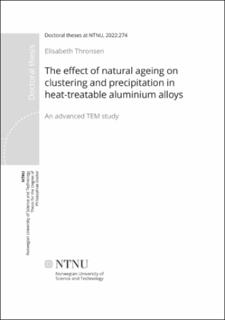| dc.contributor.advisor | Holmestad, Randi | |
| dc.contributor.advisor | Akola, Jaakko | |
| dc.contributor.advisor | van Helvoort, Antonius T. J. | |
| dc.contributor.advisor | Wenner, Sigurd | |
| dc.contributor.author | Thronsen, Elisabeth | |
| dc.date.accessioned | 2022-09-26T08:35:58Z | |
| dc.date.available | 2022-09-26T08:35:58Z | |
| dc.date.issued | 2022 | |
| dc.identifier.isbn | 978-82-326-5977-7 | |
| dc.identifier.issn | 2703-8084 | |
| dc.identifier.uri | https://hdl.handle.net/11250/3021199 | |
| dc.description.abstract | The consumption volume of aluminium (Al) alloys is expected to increase in the coming years. They are typically used in the automotive industry, where light-weighting has become a major design consideration to save fuel, the packaging and construction industry. Aluminium is an infinitely recyclable material and 75% of all the aluminium ever produced is still in use.
This work concerns wrought, heat-treatable Al alloys. These alloys gain their strength from metastable, nanoscale precipitates formed in during the last stage of the alloy’s thermomechanical treatment known as artificial ageing. The precipitates hinder dislocation motion, thereby significantly increasing the strength of the alloy. The precipitates are preceded by solute clusters or Guinier-Preston (GP) zones formed in the initial stages of artificial ageing or during room temperature storage prior to artificial ageing. Understanding the atomic structure of clusters, GP zones are precipitates and how they evolve is important for developing new alloys and also for modelling the mechanical properties of Al alloys.
Among the main findings, the previously unknown crystal structure of the GPI zones in Al-Zn-Mg(-Cu) alloys were solved by analysing atomically resolved scanning transmission electron microscopy (STEM) images. The atomic models were compared with electron diffraction patterns to ensure their validity. Further, the effect of the GPI zones on the precipitation during artificial ageing was investigated and it was concluded that the GPI zones undergo partial reversion upon ageing above a critical temperature. Moreover, the effect of pre-deformation on precipitation was investigated on heavy deformed Al-Mg-Cu-Si alloys and it was found that increasing the solute content in the matrix increased the precipitation away from the deformation induced defects. A major part of this work relied on scanning electron diffraction combined with advanced data analysis to obtain statistics of the precipitate distribution or to obtain diffraction patterns of single particles. Parts of this work is dedicated to implementing and improving data analysis approaches of such data, which typically rely on analysing 400 000 diffraction patterns. It is emphasised that the employed methods are considered to have potential also for other multi-phase materials. | en_US |
| dc.language.iso | eng | en_US |
| dc.publisher | NTNU | en_US |
| dc.relation.ispartofseries | Doctoral theses at NTNU;2022:274 | |
| dc.relation.haspart | Paper 1: Lervik, Adrian; Thronsen, Elisabeth; Friis, Jesper; Marioara, Calin Daniel; Wenner, Sigurd; Bendo, Artenis; Matsuda, Kenji; Holmestad, Randi; Andersen, Sigmund Jarle. Atomic structure of solute clusters in Al-Zn-Mg alloys. Acta Materialia 2020 ;Volum 205. https://doi.org/10.1016/j.actamat.2020.116574 This is an open access article under the CC BY license | en_US |
| dc.relation.haspart | Paper 2: Thronsen, Elisabeth; Frafjord, Jonas; Friis, Jesper; Marioara, Calin Daniel; Wenner, Sigurd; Andersen, Sigmund Jarle; Holmestad, Randi. Studying GPI zones in Al-Zn-Mg alloys by 4D-STEM. Materials Characterization 2022 ;Volum 185. https://doi.org/10.1016/j.matchar.2021.111675 This is an open access article under the CC BY license | en_US |
| dc.relation.haspart | Paper 3:
Thronsen, Elisabeth; Shah, S.; Hatzoglou, C.; Marioara, Calin Daniel; Wenner, Sigurd; Andersen, Sigmund Jarle; Holmedal, B.; Holmestad, Randi.
The evolution of precipitates in an Al-Zn-Mg alloy | en_US |
| dc.relation.haspart | Paper 4: Thronsen, Elisabeth; Marioara, Calin Daniel; Sunde, Jonas Kristoffer; Minakuchi, Kazuhiro; Katsumi, Tetsuya; Erga, Iven; Andersen, Sigmund Jarle; Friis, Jesper; Marthinsen, Knut; Matsuda, Kenji; Holmestad, Randi. The effect of heavy deformation on the precipitation in an Al-1.3Cu-1.0Mg-0.4Si wt.% alloy. Materials & design 2020 ;Volum 186. https://doi.org/10.1016/j.matdes.2019.108203 This is an open access article under the CC BY license | en_US |
| dc.relation.haspart | Paper 5: Thronsen, Elisabeth; Mørkeseth, Hanne; Marioara, Calin Daniel; Minakuchi, Kazuhiro; Katsumi, Tetsuya; Marthinsen, Knut; Matsuda, Kenji; Holmestad, Randi. The Effect of Small Additions of Fe and Heavy Deformation on the Precipitation in an Al–1.1Mg–0.5Cu–0.3Si At. Pct Alloy. Metallurgical and Materials Transactions A 2022 s. 1-15 https://doi.org/10.1007/s11661-022-06744-9 This is an open access article under the CC BY license | en_US |
| dc.relation.haspart | Paper 6:
Thronsen, Elisabeth; Bergh, T; Christiansen, E.F.; Frafjord, Jonas; Crout, P.; van Helvoort, Antonius T. J.; Midgley, P.A.; Holmestad, Randi.
Scanning precession electron diffraction data analysis approaches for phase mapping of precipitates in aluminium alloys | en_US |
| dc.title | The effect of natural ageing on clustering and precipitation in heat-treatable aluminium alloys | en_US |
| dc.type | Doctoral thesis | en_US |
| dc.subject.nsi | VDP::Mathematics and natural science: 400::Physics: 430 | en_US |

